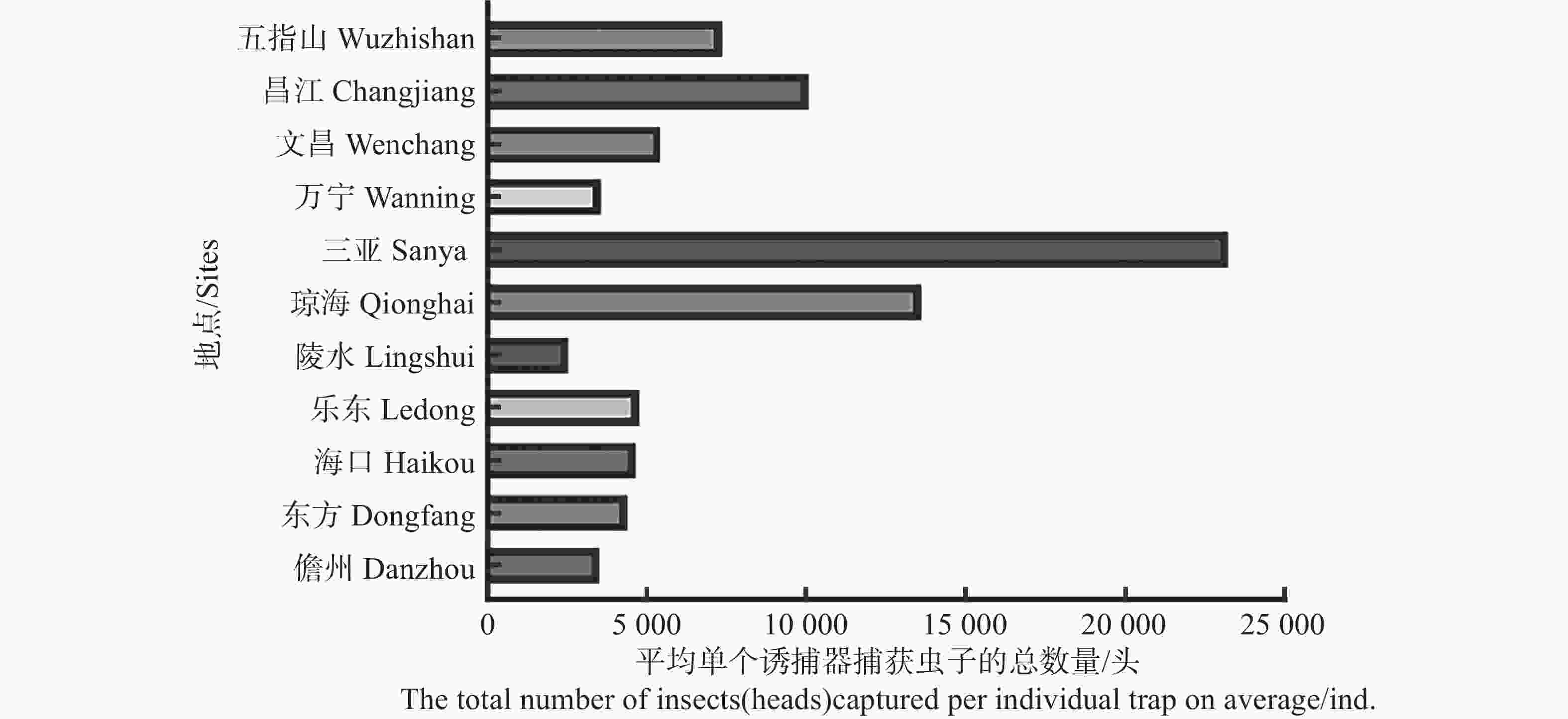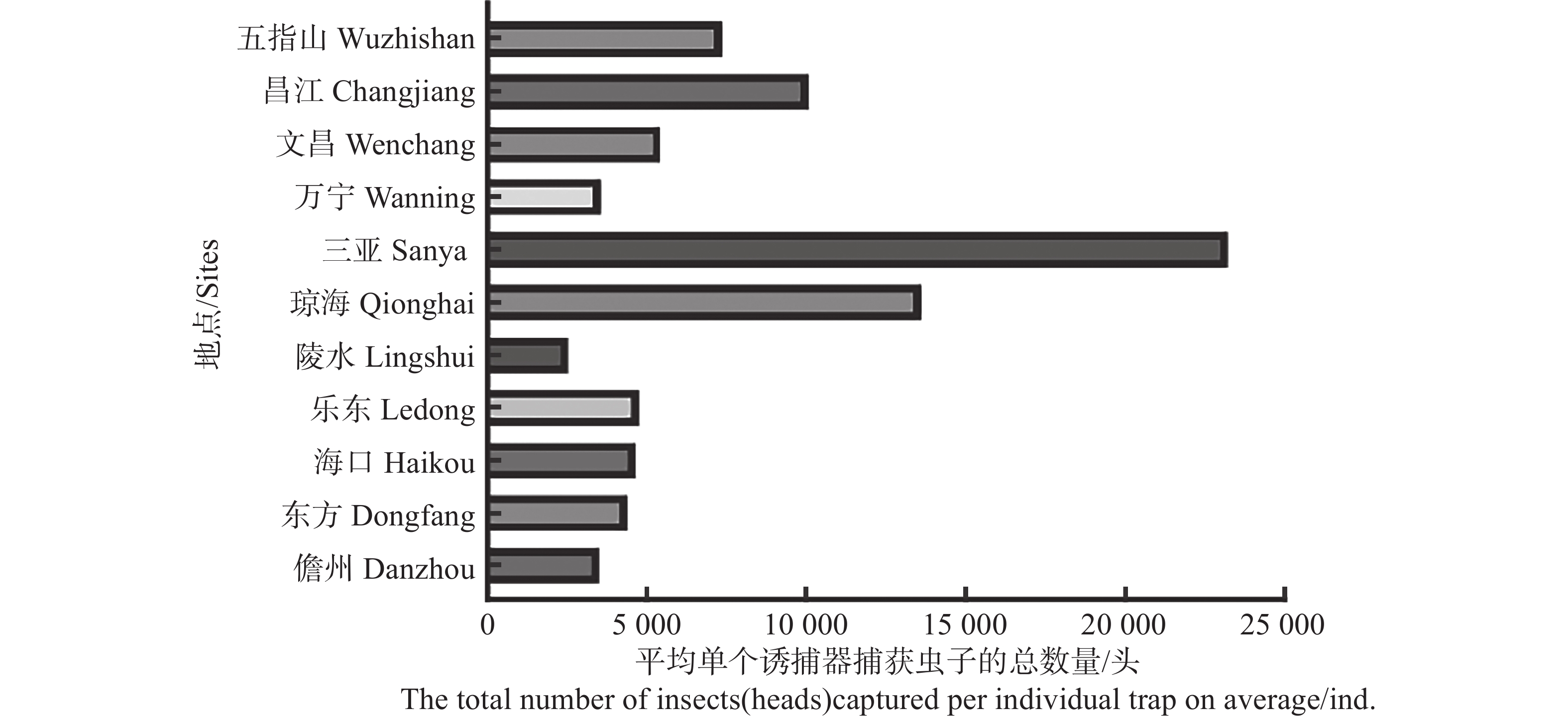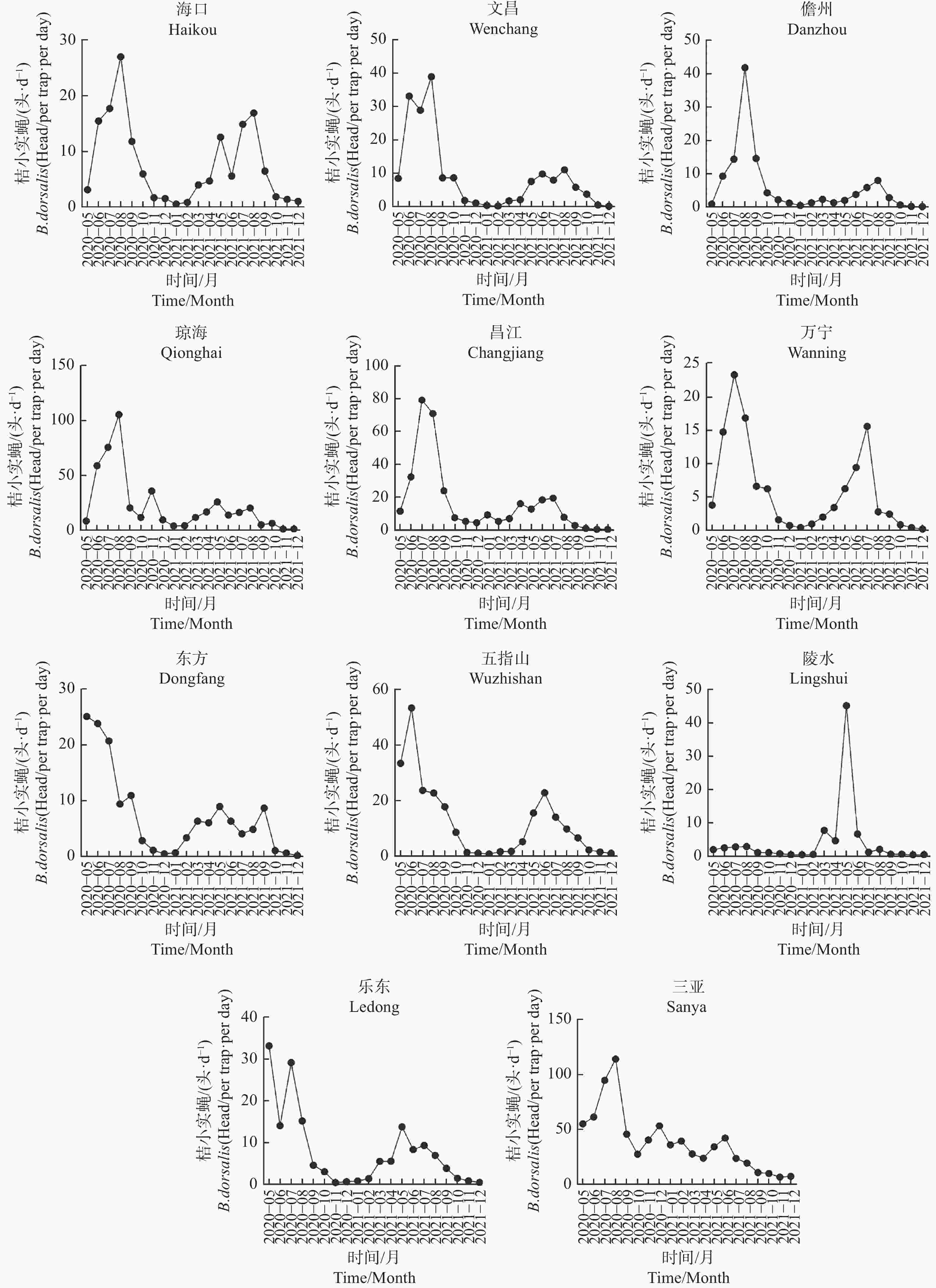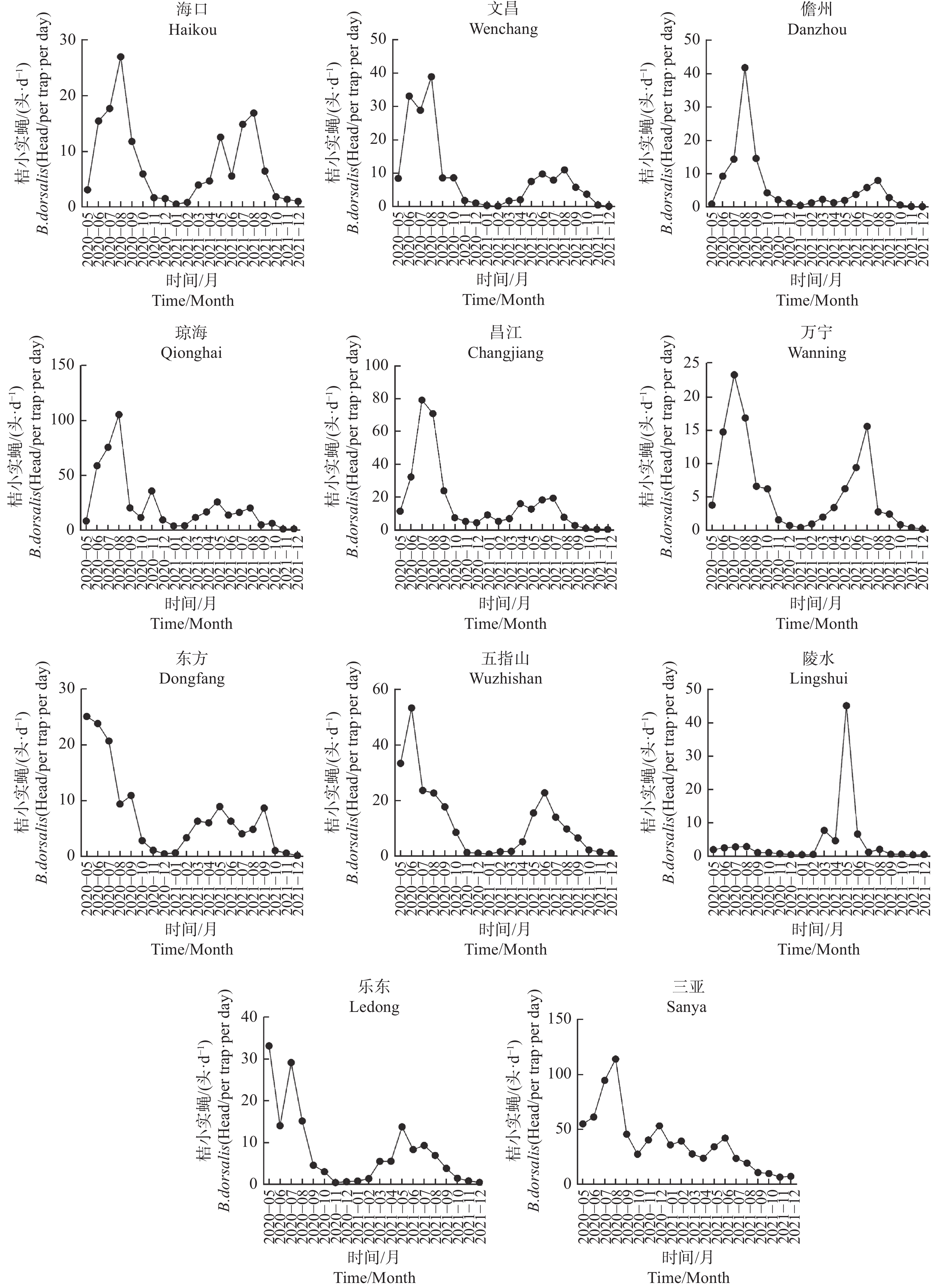-
害虫监测与预报一直是农业生产领域内安全风险防控的前哨,是农业丰产的基础[1]。增强对害虫的监测预警能力,提高其准确性和时效性,是提高对其防控能力的迫切需求[2]。海南作为中国最南端的省份,具备了发展特色热带水果的独特资源优势。然而,研究表明,广布于全岛的桔小实蝇(Bactrocera dorsalis)、瓜实蝇(Zeugodacus cucurbitae)和南亚果实蝇(Zeugodacus tau)是海南危害最大的果蔬实蝇类害虫,其寄主植物范围主要包括35种果蔬经济作物。桔小实蝇原产于东南亚[3],隶属于双翅目(Diptera)实蝇科(Tephritidae)果实蝇属(Bactrocera Macquart)的一种检疫性害虫,也是海南热带果园的优势种,对省内种植面积较广的芒果(Mangifera indica)、莲雾(Syzygium samarangense)、番石榴(Psidium guajava)和杨桃(Averrhoa carambola)等热带水果的危害极其严重。长期以来,桔小实蝇在海南分布广泛,种群数量大且世代重叠发生,成为制约海南热带水果种植业发展的重要原因之一[4]。因此,对海南主要果蔬生产区域的桔小实蝇进行监测,是对其防治的重要前提。
目前,海南桔小实蝇的田间监测主要集中在保亭、儋州、琼海、三亚、文昌等地的果园,其中,以红毛丹(Nephelium lappaceum)[5]、芒果[6]、杨桃[7]、莲雾[8]、青枣(Zizyphus mauritiana)[9]及番石榴[10]等果园为主。监测结果显示,桔小实蝇在果园的种群规模大于其他生境,且主要在7—8月间出现种群数量的急剧增长,并达到峰值;有的果园还在之前的5—6月间,还会出现一个小高峰[8];桔小实蝇发生高峰期基本上与其寄主植物的结果物候期保持一致。以上这些研究主要以某一作物或某一小面积的区域范围为对象进行实蝇监测,而且以果园的实蝇监测居多,对重要大田洋(大田洋即133.33 hm2以上连片田块)的实蝇监测则几乎没有。而这些大田洋主要分布在海南岛四周平地,是海南省农业生产的主要集中地,也是耕地组成的重要部分。另外,近年来随着农业耕种制度的改变以及轮作和套作制度的大面积推广,田间桔小实蝇寄主植物呈现多样化,其寄主植物结果期等物候时间交替交错,致使田间桔小实蝇的种群动态规律可能发生变化。因此,本研究团队通过比较海南不同区域和大田洋的桔小实蝇种群动态,为防治桔小实蝇提供更加精准的预判数据作支撑。
-
桔小实蝇诱捕器和引诱剂均来自广州瑞丰生物科技有限公司生产的便携式实蝇诱捕器(直径5 cm,高度6 cm,需与引诱剂、矿泉水瓶配合使用)和桔小实蝇引诱剂(包含甲基丁香酚等引诱成分)。
-
分别于2020−04−28—2020−04−30在海南的11个区域(表1)的瓜菜地或果园进行桔小实蝇的监测。监测样地基本选取在瓜果蔬菜种植区域。每个监测样地各放置4个桔小实蝇诱捕器。各诱捕器之间的距离不少于500 m。
监测地点
Monitoring location监测面积/km2
Monitoring area/km2纬度/°N,经度/°E,
latitude/°N, Longitude/°E主要寄主植物
Main host plants1.儋州市长坡洋瓜菜生产基地
1.ChangpoYang Guacai Production Base in Danzhou City7.794 19.708 5
109.415 2瓜类、茄果类、椒类、豆类等
Melons, eggplants, peppers, beans, etc2.东方市板桥镇
2. Banqiao Town, Dongfang City7.961 18.833 1
108.677 7西瓜、哈密瓜等瓜类、茄果类、豆类等
Watermelon, cantaloupe, solanaceae vegetaibles, beans, etc3.海口市桂林洋开发区
3. Guilinyang Development Zone, Haikou City9.622 19.996 0
110.492 6瓜类、茄果类、椒类、豆类等
Melons, sikabaceae plants, peppers, beans, etc4.乐东市黄流镇抱孔洋
4. Baokongyang, Huangliu Town, Ledong City4.445 18.509 3
108.863 4瓜果类、豆类
Melons, Fruits and legumes5.陵水县妙景村
5. Miaojing Village, Lingshui County8.444 18.559 4
110.085 6西瓜、哈密瓜等瓜类、茄果类、椒类、豆类
Watermelon, cantaloupe and other melons, solanaceae plants, peppers, and beans6.琼海市大路洋
6. Daluyang, Qionghai City5.126 19.390 5
110.456 3瓜类、茄果类、椒类、豆类、番石榴等水果
Melons, eggplants, peppers, legumes, guava and other fruits7.三亚市凤凰国际机场
7. Sanya phoenix international Airport4.691 18.327 9
109.413 2芒果等水果、茄果类、椒类、豆类等
Mango and other fruits, solanaceae gplants, peppers, beans, etc8.万宁市大奶洋
8. Danaiyang in Wanning City8.278 18.772 4
110.428 6瓜类、茄果类、椒类、豆类等
Melons, solanaceae plants, peppers, beans, etc9.文昌市冠南村
9. Guannan Village, Wenchang City4.837 19.469 7
110.777 2瓜类、茄果类、椒类、豆类等
Melons, eggplants, peppers, beans, etc10.昌江县七叉镇
10. Qicha Town, Changjiang County6.401 19.077 3
109.047 7芒果等水果、茄果类、椒类、豆类等
Mango and other fruits, solanaceae plants, peppers, beans, etc11.五指山市毛阳镇
11. Maoyang Town, Wuzhishan City3.117 18.919 6
109.454 4瓜类、茄果类、椒类、豆类等
Melons, solanaceae plants, peppers, beans, etcTable 1. Monitoring location
-
监测时,将对应的实蝇引诱剂各自缓缓滴到诱芯面上,单次使用2 mL,矿泉水诱瓶注入少量的5%(v/v)高效氯氰菊酯,诱捕器和矿泉水瓶拧紧衔接,用挂扣或者铁丝穿过诱捕器顶部的悬挂孔,挂置于桔小实蝇寄主植物上或邻近的非寄主植物上,诱捕器高度一般距离地面1.5 m左右,应避免被树叶遮蔽,但要有较好透光性且避免阳光直射。每半月定期收集诱捕器内的实蝇并同时更换诱瓶,每个月添加1次引诱剂,以确保达到诱捕效果。采集完成后做好后续监测记录工作。
-
海南各地区气温和降水情况从海南省气象局查询得知,采用GraphPad Prism9.0.2和SPSS 27.0进行数据分析和绘图。
-
根据2020年5月至2021年12月间的桔小实蝇种群监测结果(图1),由图1可知,海南11个监测地点均可诱捕到桔小实蝇。其中,三亚监测点平均单个诱捕器诱捕到的桔小实蝇总头数为23 194.50头,是所有监测点中最高的,其他监测点平均单个诱捕器诱捕到的桔小实蝇总头数为琼海(13 600.75头)、昌江(10 069.67头)、五指山(7 347.71头)、文昌(5 420.75头)、乐东(4 755.25头)、海口(4 648.00头)、东方(4 384.50头)、万宁(3 557.00头)、儋州(3 506.75头)、陵水(2 540.50头),陵水监测点是所有监测点中最低的。监测结果表明海南不同区域的桔小实蝇种群数量是不相同的。

Figure 1. The total number of B. dorsalis captured by a single trap on average at different monitoring sites during the entire monitoring period
每个诱捕器每天捕获的实蝇数(Flies per trap per day, FTD)是一个种群指数,表示在诱捕器暴露在野外的特定时期内,每个诱捕器每天捕获的目标物种的平均数量[11]。由每个监测点的桔小实蝇种群变化情况(图2)可知,各个监测点的桔小实蝇种群数量在2020年和2021年的变化趋势基本保持一致。桔小实蝇冬季诱捕数量总体水平较低,夏季诱捕量呈现出全年间最大的增值高峰,全年种群消长规律呈现双峰型。其中,海口、儋州、琼海、文昌等4个监测点的桔小实蝇种群数量峰值出现在8月份;万宁和昌江2个监测点的桔小实蝇种群数量峰值则是在7月份;五指山和三亚2个监测点的桔小实蝇种群数量峰值则是6月份;东方、乐东、陵水3个监测点的桔小实蝇种群数量峰值则出现在5月份。
-
通过分析11个监测点的桔小实蝇种群监测数据与气象因子间的相关性(表2)可知,桔小实蝇种群数量与平均温度、最高温度、最低温度等气象因子间存在正相关性,尤其是东方、海口、乐东、万宁、文昌、五指山等地的相关性较高,三亚的相关性最低。桔小实蝇监测数据与降水量、雨日数的相关性不明显,部分区域与日照时数的相关性较好,如东方、海口、乐东、万宁、文昌等地,部分区域与平均湿度的相关性较好,如东方的相关系数r=−0.671,P=0.002<0.01。整体来看,东方、海口、乐东、万宁、文昌、五指山等地的桔小实蝇监测数据与平均温度、最高温度、最低温度和日照时数等气象因子间存在一定的相关性。另外,儋州、陵水、琼海、三亚、昌江等地区的桔小实蝇监测数据与气象因子的相关性均不太高。
监测地点
Monitoring site桔小实蝇种群数量与气象因子的相关系统R
Correlation coefficient r between B. dorsalis population and meteorological factors平均温度/℃
Average
Temperature/℃最高温度/℃
Maximum
Temperature/℃最低温度/℃
Minimum
Temperature/℃降水量/mm
Precipitation/mm平均湿度/%
Average
Humidity/%雨日数/d
Days with
Rain/d日照时数/h
Sunshine
Hours/h儋州 Danzhou 0.334 0.335 0.349 0.274 0.118 0.452 0.088 东方 Dongfang 0.616** 0.610** 0.603** −0.272 −0.671** −0.279 0.677** 海口 Haikou 0.652** 0.663** 0.635** 0.169 −0.191 0.352 0.539* 乐东 Ledong 0.639** 0.720** 0.519* 0.144 −0.058 0.126 0.469* 陵水 Lingshui 0.256 0.244 0.222 −0.184 0.111 −0.029 0.425 琼海 Qionghai 0.420 0.419 0.416 −0.014 −0.132 0.083 0.312 三亚 Sanya 0.223 0.234 0.203 0.113 0.091 0.100 −0.140 万宁 Wanning 0.612** 0.615** 0.589** −0.105 0.016 −0.011 0.538* 文昌 Wenchang 0.566* 0.568* 0.551* −0.022 −0.346 −0.027 0.519* 昌江 Changjiang 0.438 0.468* 0.411 0.029 −0.082 0.301 0.266 五指山 Wuzhishan 0.665** 0.683** 0.580** 0.063 0.061 0.247 0.327 注:**表示在0.01级别(双尾)相关性显著。*表示在0.05级别(双尾)相关性显著。 Note:** indicates significant correlation at the 0.01 level (two-tailed); * indicates significant correlation at the 0.05 level (two-tailed). Table 2. Correlation between population monitoring data and meteorological factors of the B. dorsalis at different locations
-
桔小实蝇是影响海南果蔬生产的重要外来入侵害虫之一。在海南岛进行大范围的监测,掌握桔小实蝇种群动态变化规律,有利于对其进行高效防治策略的制定和扩散机制的探讨。本研究选取了海南11个重要的大田洋进行桔小实蝇种群监测,发现桔小实蝇在5—8月间出现种群高峰期,在11—12月间则出现低谷期。桔小实蝇的种群数量波动与其环境温度和日照时数等气象因子间存在一定的关联性。这些可为今后海南农业生产中桔小实蝇防控提供了虫情判断依据,并为其防治策略的制定提供数据基础。
桔小实蝇在中国南方全年发生,具有明显的世代重叠现象,每年可发生2~8代[12]。文献[13]显示,海南儋州桔小实蝇高峰期发生于6月,但其冬季种群数量较低。海南芒果园桔小实蝇雄虫种群数量在2月(短时高峰)和8月(高峰)出现高峰,12月至1月为低谷[6]。海南琼海市番石榴园桔小实蝇种群在6月下旬至7月上旬或8月上旬为发生高峰期[10]。海南三亚地区的实蝇种群高峰期均在7月中旬[14]。桔小实蝇在海南杨桃园的发生高峰期在7月中下旬,其种群密度与杨桃被害率呈显著正相关性[7]。本研究的监测结果显示,海南桔小实蝇的种群发生高峰期为5—8月,且在冬季海南桔小实蝇种群数量显著低于夏季,呈现低谷期,这与已有的研究结果一致。这表明,除了果园之外,在海南重要的大田洋区域,桔小实蝇种群仍然呈现出类似的种群波动变化规律。因此,本研究团队推测5—8月为桔小实蝇种群发生的高峰期,这在海南具有普遍性。
气候因素主要包括温度、湿度、光照、气流、气压等,这些因素单独或综合作用来影响种群数量[15]。文献[16]报道,温度和湿度是影响桔小实蝇分布的重要气候因子。其中,温度对海南儋州桔小实蝇种群数量的影响较大;温度升高,种群数量呈指数增长[13]。然而,本研究的结果显示儋州、陵水、琼海、三亚、昌江等地区的桔小实蝇监测数据与气象因子的相关性均不太高。这可能与本研究团队在儋州等地选取的监测点为田洋有关,田洋不仅面积大,而且寄主植物多样。文献[17]显示,寄主植物是影响桔小实蝇种群变动和大发生的重要因素之一。使用植物物候模型较天气模型更实用易用,能更准确地预测害虫种群[18],这也是本研究中部分监测点的桔小实蝇种群与气象因子相关性不太高的主要原因。如何利用种群监测数据及其生物因子和非生物因子来准确预测预报桔小实蝇种群变化将在后续的研究中进一步深入研究。
Population dynamics of Bactrocera dorsalis and the impact of meteorological factors
doi: 10.15886/j.cnki.rdswxb.20240084
- Received Date: 2024-05-20
- Accepted Date: 2025-02-28
- Rev Recd Date: 2024-05-28
- Available Online: 2025-03-27
- Publish Date: 2025-09-25
-
Key words:
- Pest Monitoring and Forecasting /
- Bactrocera dorsalis /
- populations dynamic /
- Hainan /
- meteorological factor
Abstract: To clarify the population dynamics of Bactrocera dorsalis in Hainan region, surveys were conducted on the population of B. dorsalis in the main agricultural production areas of Hainan, and the correlation between the population and meteorological factors was explored. The results showed that B. dorsalis can occur throughout the year in Hainan, with the peak occurrence period from May to August, and the low occurrence period in winter from November to December. The monitoring data of B. dorsalis populations in some areas were positively correlated rwith average temperature, maximum temperature, and minimum temperature, but not significantly with precipitation, relative humidity, and rainy days was. This provides a good referece for formulating control strategies for B. dorsalis in Hainan.
| Citation: | MO Wu, GONG Zhi, YI Kexian. Population dynamics of Bactrocera dorsalis and the impact of meteorological factors[J]. Journal of Tropical Biology, 2025, 16(5): 701-706. doi: 10.15886/j.cnki.rdswxb.20240084 |








 DownLoad:
DownLoad:
